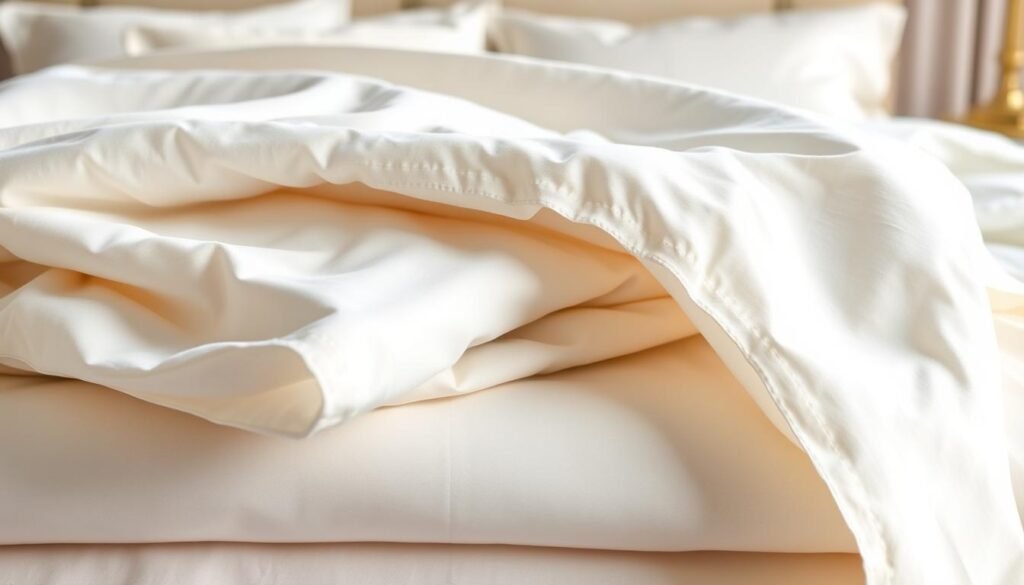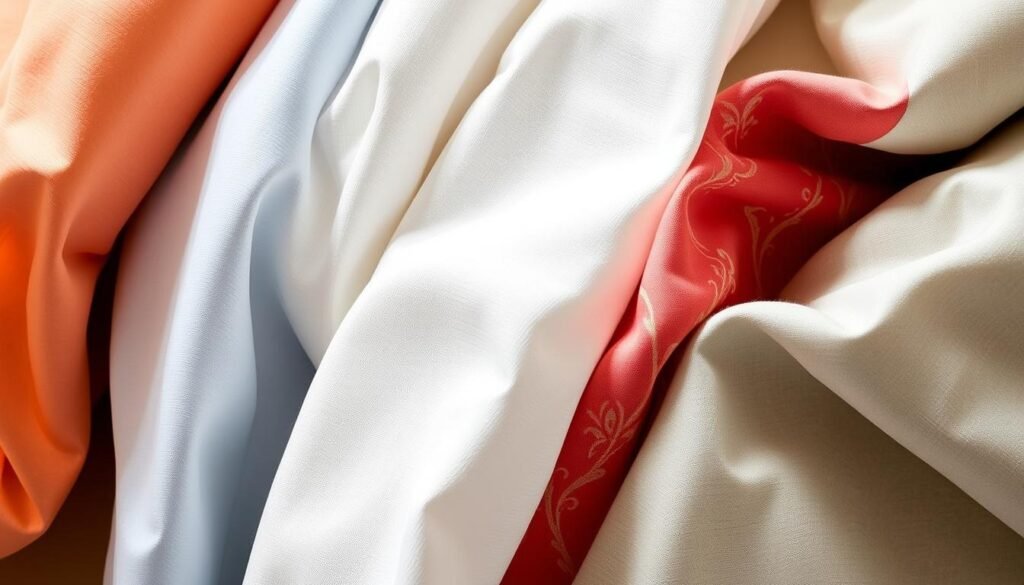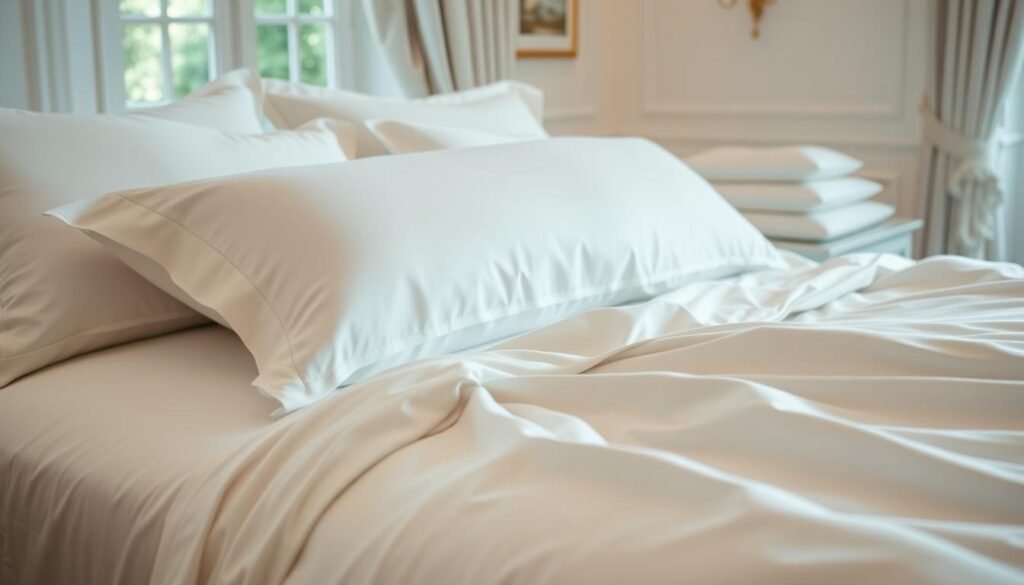The best thread count for sheets ranges from 200 to 600. This varies based on whether they’re percale or sateen. However, thread count isn’t the key factor in sheet quality.
The type of cotton and yarns used matter more. These elements determine the softness and durability of your sheets. Some manufacturers inflate thread counts to make sheets seem more luxurious.
Experts say high-quality percale sheets have a thread count of 250 to 300. For sateen sheets, the ideal range is between 300 and 600. Choose wisely to boost your sleep experience.
Table of Contents
ToggleKey Takeaways
- The best thread count for sheets generally ranges from 200 to 600, depending on the fabric type.
- Thread count is not the only factor that determines the quality of sheets – the type of cotton and yarn used are more important.
- Manufacturers sometimes inflate thread counts to make their sheets appear more luxurious.
- Percale sheets with a thread count of 250 to 300 are considered optimal by experts.
- High-quality sateen sheets typically have a thread count between 300 and 600.
What is Thread Count?
Thread count measures bedding fabric quality and comfort. It counts yarns in a square inch of fabric. Higher counts often mean finer yarns, allowing more strands per inch.
Understanding the Meaning of Thread Count
Thread count originated before synthetic fibers, assuming single-strand yarns. Modern techniques use multi-ply yarns, which can affect actual thread count.
True thread count considers fiber quality, composition, and weaving process. Thread count alone doesn’t determine softness, durability, or overall quality. Fiber type, weaving technique, and finishing processes also matter.
- Basic quality linen typically has a thread count of 132 to 144.
- Good quality linen ranges from 180 to 220 thread count.
- Fabrics categorized as great quality have a thread count beyond 300.
- Linen classified as excellent quality boasts a thread count beyond 400.
- The best quality linen typically exceeds 500 in thread count.
High thread count doesn’t always mean better quality. Some manufacturers inflate counts, creating a mismatch with actual thread count.
Consider fabric type, fiber quality, and weaving process when evaluating bedding. These factors contribute to overall quality beyond just thread count.
Optimal Thread Count Ranges
Choosing the right sheets requires knowing optimal thread counts for different materials and weaves. Ideal thread counts vary based on the type of sheet. Textile experts provide guidance on this matter.
For Percale Sheets:
Quality percale sheets have thread counts between 250 and 300. Fine, high-quality cotton yarns can reach 400 to 500 threads. Percale’s plain weave allows fewer threads per square inch than sateen.
For Sateen Sheets:
Sateen sheets excel with thread counts from 300 to 600. The ideal number is around 400. Sateen’s satin weave permits higher thread counts, creating a silkier feel.
Higher thread counts don’t always mean better quality. Some makers use thin, low-quality threads to inflate numbers. Thread count is just one quality indicator.
When buying cotton sheets, consider fabric quality, construction, and weave. Thread count alone doesn’t determine comfort. Understanding optimal ranges helps you make informed choices for luxurious sleep.
The Best Thread Count for Sheets
Finding perfect bed sheets often involves considering thread count. Experts and our tests suggest a range of 300 to 500 for high-quality sheets. This range balances silky smoothness with breathability for comfortable sleep.
Sheets above 500 thread count may feel too heavy. Those below 300 could be rougher and less durable. Quality cotton and fabric construction are as important as thread count.
The perfect thread count range isn’t just about numbers. It’s about cotton quality and fabric construction. These factors are key to selecting the ideal bedding thread count.
“A higher thread count generally refers to fabrics with a thread count of 300-500 for cosier and more luxurious bedding.”
Some makers use multi-ply yarns to inflate thread count. This can result in lower-quality fabric. Look beyond the recommended thread count for sheets. Consider overall quality and construction too.
Focus on the perfect thread count range of 300 to 500. Consider cotton quality and fabric construction. This approach helps you find the best sheets for restful sleep.
When Thread Count Matters
Thread count is often seen as a quality indicator for sheets. However, it only matters for 100% cotton sheets with a single-ply weave. Higher thread counts may suggest finer, smoother yarns, contributing to a more luxurious feel.
For other materials like polyester or blends, thread count can be misleading. Manufacturers may inflate numbers using thin yarns or deceptive counting methods. This makes thread count unreliable for non-cotton sheets.
Consider fiber content, construction, and weave when choosing sheets. The thread count importance for cotton sheets lies in its ability to provide a soft, smooth, and durable fabric, but it should not be the sole deciding factor.
“A higher thread count doesn’t always mean better quality. It’s important to consider the fiber content, construction, and weave of the sheets as well.”
When to consider thread count is typically for cotton sheets ranging from 200 to 600. This applies to varieties like percale, sateen, and twill. Linen sheets, however, are best with counts between 80 and 130.
Single-ply cotton sheets with a thread count between 200 and 600 are where it truly matters. It can indicate yarn quality and overall fabric craftsmanship. Look beyond thread count to ensure you’re investing in high-quality, long-lasting sheets.
Focus on single-ply cotton fabric quality for a truly luxurious sleeping experience. This approach will help you choose sheets that offer both comfort and durability.

When to Ignore Thread Count
Thread count isn’t always the best measure of sheet quality. This is especially true for non-cotton sheets. Some makers inflate thread counts artificially. They use multiple-ply yarns or thin synthetic fibers.
These tactics boost numbers but don’t improve comfort. High thread counts don’t always mean better sheets. It’s crucial to consider other factors for quality.
Misleading or Irrelevant Thread Counts:
Polyester, rayon, linen, and silk have their own quality measures. Thread count matters less for these fabrics. Focus on fiber content, construction, and weave instead.
Linen sheets typically have an average thread count range of 80-150 threads per square inch. Cotton sheets generally fall within the thread count range of 200-400 threads per square inch.
Silk sheets often feature higher thread counts, typically between 400-600 threads per square inch. Synthetic fiber sheets vary in thread count based on the fabric used. They’re often soft but less breathable than natural fibers.
Softness and thread count links can change with different fibers. The ideal thread count depends on the fabric texture. Be aware of misleading thread count claims.
Some sheets have high thread count but low quality. Look beyond thread count to find the best sheets for you. Consider other factors to make the right choice.
Other Essential Factors
Thread count isn’t the only thing to consider when buying sheets. Fiber content and cotton quality also affect softness, durability, and performance. These factors are just as important as thread count.
Fiber Content and Quality
Sheets made from long-staple or extra-long-staple cotton are usually softer and more durable. Pima and Supima cotton are examples of high-quality fibers. The length of cotton fibers used greatly impacts the sheet’s quality and feel.
Construction and Weave
Fabric construction and weave significantly influence sheet performance. Percale feels crisp and lightweight, while sateen is smooth and silky. Combing cotton to remove impurities can improve quality.
Single-ply and multi-ply yarns also affect the sheets’ overall durability. These factors contribute to the final product’s quality and comfort.
| Fabric Characteristic | Description |
|---|---|
| Cotton Fiber Length | Long-staple and extra-long-staple cotton, such as Pima and Supima, provide superior softness and durability compared to shorter cotton fibers or synthetic blends. |
| Fabric Construction | Percale’s crisp, lightweight feel differs from the smooth, silky texture of sateen. The use of single-ply or multi-ply yarns also affects the sheets’ overall quality and performance. |
| Manufacturing Processes | Factors like combing the cotton to remove impurities can enhance the sheets’ softness and longevity. |
Consider factors beyond thread count, cotton sheet fiber quality, and sheet fabric construction and weave when choosing sheets. These elements help ensure you find high-quality sheets that suit your needs and preferences.

Finding the Best Thread Count for Sheets
Shopping for high-quality sheets? Look beyond thread count. Consider comfort and durability too. Choose between crisp percale sheets or silky sateen sheets.
Pick sheets made from high-quality cotton fibers like pima or Supima. These are softer and more durable. Avoid extremely high thread counts. They may use misleading marketing or lower-quality materials.
Look for sheets in the 300-500 thread count range. This offers the best balance of softness and breathability. Try different options to find what feels best for you.
Consider factors beyond thread count. This ensures you select the best sheets for your needs and budget.
| Linen Quality | Thread Count Range |
|---|---|
| Basic Quality | 132 to 144 |
| Good Quality | 180 to 220 |
| Great Quality | 300 and above |
| Excellent Quality | 400 and above |
Think about organic and sustainable manufacturing practices too. Check the quality of sewing and finishing. Ethical Bedding uses eucalyptus silk, sourced with 95% less water than cotton.
“Quality bedding can feature a single-ply cotton with a thread count between 180 to 300.”
Conclusion
The ideal thread count for sheets varies. A range of 300-500 is often considered best for high-quality cotton sheets. However, thread count is just one factor to consider when choosing bedding.
Fiber content, construction, and weave are equally important. These elements determine the softness, durability, and comfort of your sheets. Personal preferences and sleep needs should guide your choice.
Look beyond thread count when shopping for sheets. Consider whether you prefer crisp percale or smooth sateen. Focus on finding bedding that meets your specific requirements.
Quality sheets result from a combination of factors. These include thread count, material, and construction. Explore your options to find the perfect sheets for your needs.
Prioritize features that matter most to you. This approach will help you find sheets that enhance your sleep and overall well-being. Invest time in choosing the right bedding for restful nights.
FAQ
What is the best thread count for sheets?
Good sheets typically have thread counts between 200 and 600. The sweet spot for high-quality sheets is 300 to 500. This range offers a balance of smoothness and breathability for a cozy sleep.
How important is thread count in determining sheet quality?
Thread count is just one factor in sheet quality. Cotton type, yarn quality, and fabric construction are more crucial. These elements determine softness, durability, and overall sheet quality.
What is the optimal thread count range for percale and sateen sheets?
Quality percale sheets have thread counts of 250 to 300. For fine, high-quality percale, aim for 400 to 500. Sateen sheets are best with 300 to 600 thread count, with 400 being ideal.
When is thread count truly relevant?
Thread count matters for 100% cotton sheets with single-ply weave. Higher thread counts may indicate finer, smoother yarns. This can lead to a more luxurious and comfortable feel.
When should I ignore thread count?
Ignore thread count for sheets made from materials other than 100% single-ply cotton. This includes polyester, blends, or multi-ply yarns. Instead, focus on fiber content, construction, and weave for true quality.
What other factors should I consider when choosing high-quality sheets?
Look beyond thread count when selecting sheets. Consider fiber quality, like long-staple or extra-long-staple cotton. Pay attention to construction (single-ply vs. multi-ply) and weave (percale vs. sateen).
These factors impact the overall softness, durability, and comfort of your sheets. Choose wisely for the best sleep experience.

